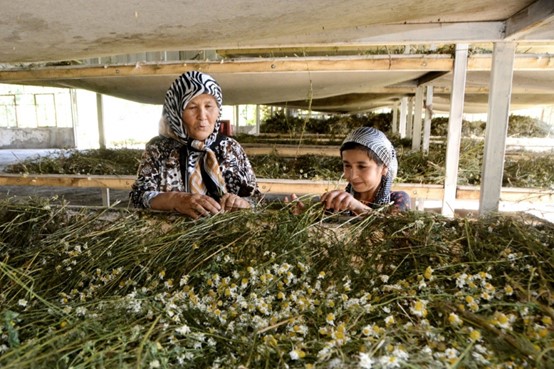FAO and the GEF partnering for sustainable agrifood systems solutions

Climate change threatens our ability to ensure global food security, eradicate poverty, and achieve sustainable development. While agriculture is the sector most vulnerable to the effects of changing climate, it also accounts for up to a third of total global emissions. Resilient and sustainable agrifood systems solutions must be at the heart of global climate action.
FAO has been partnering with the Global Environment Facility for over two decades to help countries access climate finance for agrifood system solutions that enable communities to adapt, build resilience, mitigate emissions, and ensure food security and nutrition while reversing environmental degradation and its impacts. Since 2018 alone, FAO has leveraged over USD 370 million in GEF funding that is enabling thousands of communities to build climate resilience across 96 countries, while also mitigating over 570 million tons of greenhouse gas emissions.
As the international community comes together in Dubai for the 2023 UN Climate Change Conference COP28, let’s look at how the FAO-GEF partnership is supporting countries in addressing the interlinked climate, food, nutrition, water, land, and biodiversity challenges.
Empowering women from forest-dependent communities in Uzbekistan

Less than nine percent of Uzbekistan has forest coverage, and even this is rapidly shrinking because of climate change, unsustainable animal husbandry, increasing demand for wood, and the expansion of irrigated agriculture. Forest degradation is a serious threat to the livelihoods of local communities dependent on forest resources as their main source of income.
To improve sustainability, FAO, in close collaboration with national partners and the Forestry Agency under the Ministry of Natural Resources of Uzbekistan, came up with a gender strategy to empower women from forest-dependent communities. Since 2018, FAO’s GEF-funded project in the country has been promoting sustainable forest management practices and conducting training activities for the local communities, focusing on women from poor communities, to diversify their income to reduce pressure from the forest resources. More than 400 women residing in pilot project sites have learned how to produce environmentally friendly non-wood handicrafts for sale. Thanks to their new or improved skills, these women have increased their incomes, thus decreasing their dependence on grazing and logging, and improving the nutrition and livelihoods of their children and families.
The project’s gender strategy also recommends that at least 20 percent of leadership positions in the Forestry Agency are filled by women and at least 30 percent of graduates of forestry tertiary education institutions are women. By empowering rural women with equal opportunities, training and tools, the project has helped reduce gender-specific inequalities to that will lead to improved livelihoods for all in forestry-dependent communities, with significant impacts on poverty alleviation, the sustainable use of forests and a better life for all.
Climate-smart livestock management in Uruguay to mitigate climate change and generate income

In Uruguay, agriculture accounts for 75% of the country’s greenhouse gas emissions. A large chunk of comes from methane emitted by cattle. For a country where there are four times more cows than people, better livestock management can make enormous impacts in climate change mitigation.
Since 2020, FAO’s GEF-funded Livestock and Climate project (Ganadería y Clima), led by Uruguayan Ministry of Livestock, Agriculture and Fisheries and the Ministry of Environment, has been supporting local producers in Uruguay better manage their livestock and natural resources to increase productivity while mitigating emissions. By applying simple strategies such as adjusting herd forage, reducing overgrazing to promote pasture regrowth and improve soil conditions, the families participating in the project reported a 28% increase in income from livestock, 8% and 17% increase in beef and sheep meat production, and a decrease in emissions by 7 % per hectare and 18% per kilogram of meat produced.
FAO’s Climate-Smart Livestock portfolio is a classic example of how learnings and knowledge from one FAO-GEF project were applied to other projects to address similar environmental concerns. Following an initial project in Ecuador, FAO’s Climate-Smart Livestock projects are now benefitting smallholder producers in Uruguay, Dominican Republic, and Costa Rica.
Livelihood shifts in Lao PDR to build resilience to climate risks and protect wetland biodiversity

Freshwater wetlands are vital for human survival. They are ecosystems housing unique biodiversity, reducing the risk of flood and drought impacts, and also improving water supply. Lao People's Democratic Republic (Lao PDR or Laos) is intimately associated with some of the world’s most significant wetlands. The Mekong River system covers 88% of the country and supports communities of thousands who depend on it. However, increased extreme climate events and variability are threatening wetland biodiversity and the livelihoods and food security that rely on it.
Since 2019, FAO’s climate change adaptation project funded through the GEF’s Least Developed Countries Fund (LDCF) has supported local communities in 109 villages surrounding the Xe Champhone and Beung Kiat Ngong Ramsar sites to adapt to climate change, implement disaster risk management strategies, and reduce the vulnerability of the wetlands to the impacts of climate change. By using ecosystem- and community-based adaptation strategies, farmers learned how to diversify their production away from wet season rice and non-native fish to cultivating dry-season rice, vegetables, native fish, and livestock, minimizing both the risk of climate disasters and impacts on wetland biodiversity while supporting nutrition and livelihoods.
The project brought 85 960 hectares wetland areas under effective management, supported creation of 4 reserves in the Xe Champhone, created and supported 48 “Fish Conservation Zones” that benefitted over 13 800 families, and restored 218 hectares of forest area. The project’s activities directly benefitted over 10 400 people (36% women) with on-farm interventions and 2 400 people (46% women) with off-farm livelihood interventions.

